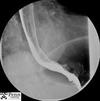Esophageal Motility Disorders Flashcards
MC Categories of Esophageal Motility Disorders
- Achalasia
- Diffuse esophageal spasm
- Nutcracker esophagus
- Hypertensive LES
- Scleroderma
A common cause of esophageal dysmotility that must be ruled out before a diagnosis of altered esophageal motor function is made
GERD
Other less common diseases that may affect esophageal motility include
- Connective tissue disorders
- DM
- Dermatomyositus
- Amyloidosis
- Chronic ideopathic intenstial pseudo-obstruction
- Alcoholism
- Chaga’s disease
Definition of achalasia
Primary esophageal motility disorder charcterized by:
Aperistalsis of distal esophagus
Failure of complete LES relaxation
Early achalasia findings may include:
Disordered peristalsis with normal LES function
Pathophysiology of Achalasia
Degeneration of ganglion cells in esophageal myoenteric plexus
- Destruction of inhibitory neurons (contain NO and VIP) due to inflammatory process
- Initiating event may be viral, and inflammatory process autoimmune in origin
- Elevated antibody titers to herpes virus
- Predominant T-lymphocyte inflammatory infiltrates
- Autoantibodies to myoenteric plexus
Natural hisotry of achalasia
- Loss of esophageal proppulsion and lack of LES relaxation
- Stasis of food bolus until intraesophageal pressure great enough allow transit into stomach
- Esophageal dilation
- Stasis of food bolus until intraesophageal pressure great enough allow transit into stomach
MC presentation of achalasia
Dysphagia
- Progressive
- Liquids and solids
- Exacerbated by emotional stress and fast eating
- Regurgitation of undigested food and aspiration: MC in advanced phase of achalsia when esophagus is dilated
- Chest pain and indigesion common: often misleading to diagnosis of GERD
2 classic barium swallow findings for achalsia
Bird’s beak narrowing of GEJ
Air-fluid level in distal esophagus
Role of endoscopy in diagnostic evaluation of suspected achalsia
Rule out pseudoachalsia due to esophageal, gastric, or pancreatic cancer involving distal esophagus or esophageal diaphragmatic hernia
Gold standard diagnostic test for achalasia
Esophagel mannometry
- Aperistalsis
- Failure of LES relaxation
- LES hypertensive
- Resting esophageal pressure elevated and non-peristaltic
- Simultaneous contractions seen in reponse to swallow
- Esophagus very dilated: low amplitude
- Vigerous achalsia: high amplitude and duration simultanous contractions (rare)
Medical treatment options and success for achalasia
- Options: reduce LES tone
- anticholangerics
- nitrates
- Ca channel blockers
- Beta blockers
- PDE inhibitors
- Success: low efficacy with high rates of adverse effects
Success of endoscopic balloon diation for achalasia
50-90% with multiple sessions in experienced hands
- Risk of perforation: 2-5% per dilation
- Less effective in young patients
RCT results (endoscopic dilation vs surgery) for achalsia
Near complete relief of symptoms at 5-year follow-up:
- Endoscopic balloon dilation: 51%
- Surgery: 95%
Success of intersphincteric botulinum toxin injection for achalasia
60-70% (short lived)
- Requires repeated injections
- Tx may lead to GERD
Standard of Care treatment for achalasia
Heller myotomy with fundoplication
- Laparoscopic distal esophageal myotomy
- myotomy 6 cm with extension of at leat 1.5 cm onto stomach
- Partial fundoplication (Dor or Toupet)
- RCT demonstrated higher postop GERD without fundoplication
Surgical treatment options for end-stage achalsia or failure of Heller myotomy with fundoplication
Esophagectomy with reconstruction (gastric pull-up or colonic interposition)
Most frequent reason for performing esophagectomy in achalasia
Iatrogenic perforation
- Other indication: esophageal cancer or dysplasia
Achalasia a known risk factor for what
Esophageal cancer
- Endoscopic surveillence offered even after surgical intervention and resolution of symptoms
Diagnosis

Achalasis
- Aperistalsis in esophageal body
- Failure of relaxation of LES
Definition of Diffuse Esophageal Spasm (DES)
Rare esophageal motility disorder characterized by:
- non-peristaltic, simultaneous contractions of distal esophagus
- occur either spontaneously or in response to swallow
- intact LES function and relaxation
Pathophysiology of DES
Unknown
Hypotheses:
- dysfunction of inhibitoary nerves (similar to achalasia)
- early stage of myoenteric plexus denervation disease
% of cases of DES that will progress to achalsia
3-5%
MC presentation of DES
- Chest pain
- rest
- after swallow
- associated with hih-amplitude and long-duration esophageal contractions
- Dysphagia
- non-progressive (different from achalasia which is progressive)
- liquids and solids
- intermittent








